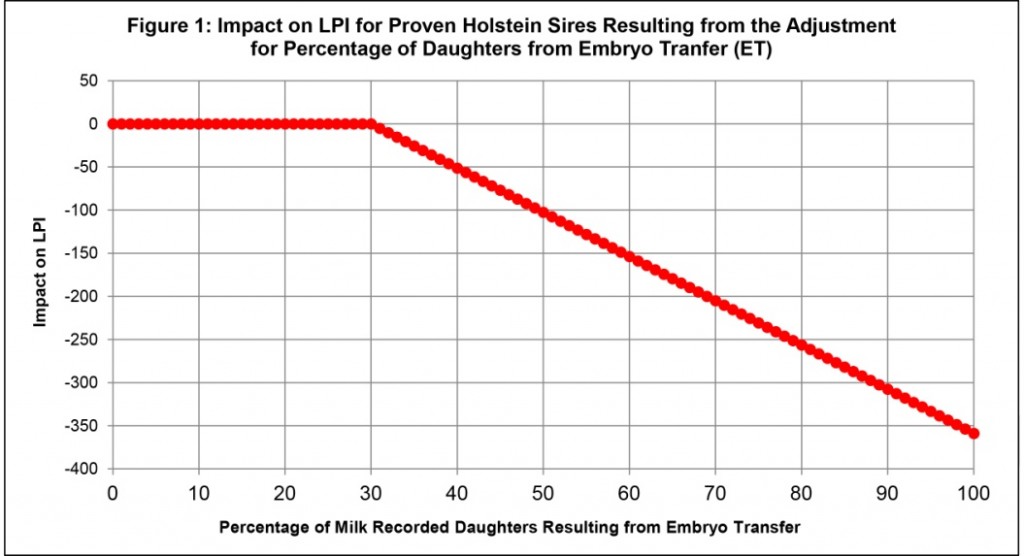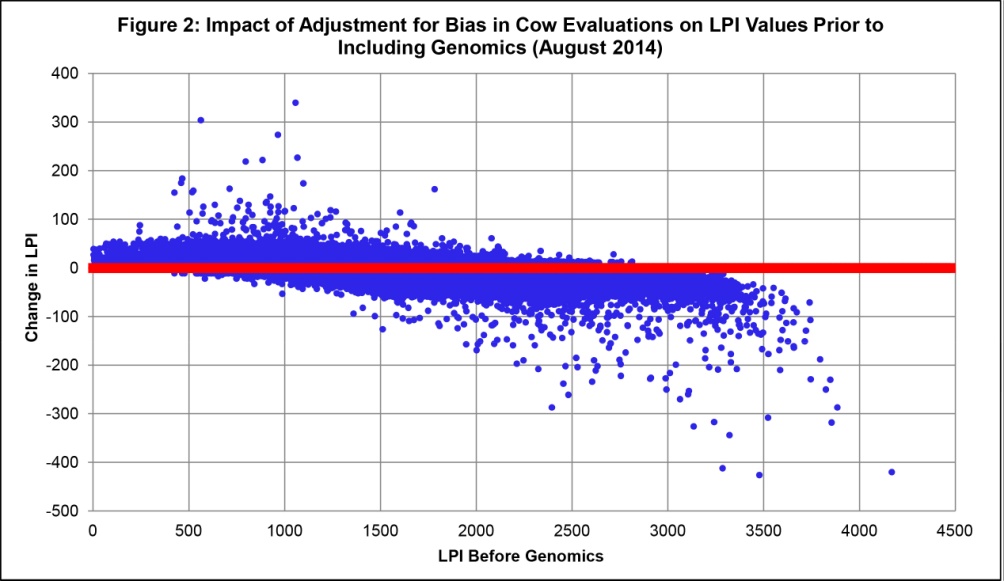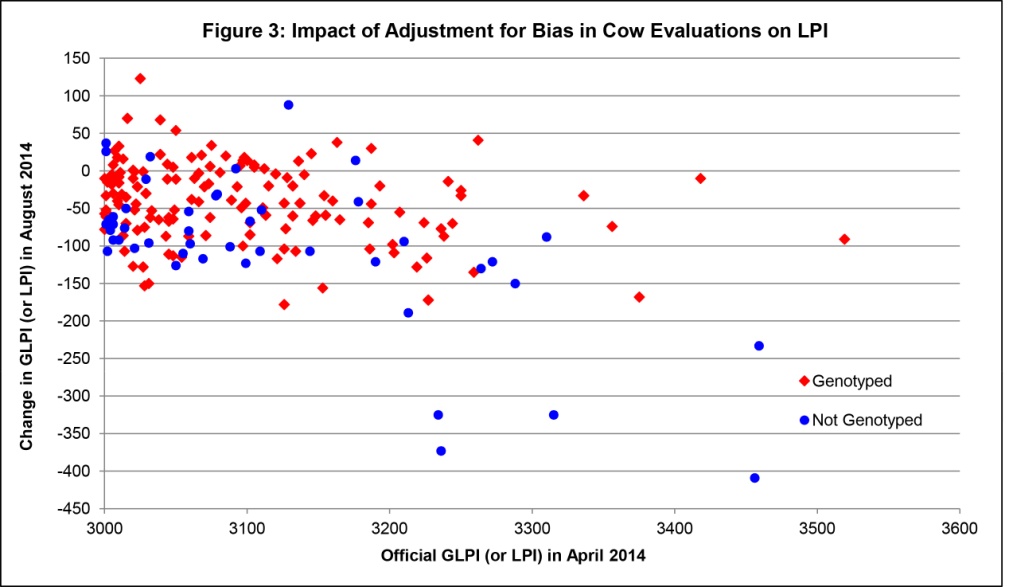Canadian Dairy Network (CDN) has been providing official genomic evaluations since 2009, which have become a very important tool for genetic selection decisions in Canada. A recent analysis carried out by CDN shows that genomic young bulls represented nearly 57% of the A.I. market share in the first half of 2014 while progeny proven sires took up the remaining 43%. As is the case with young bulls worldwide, genomic evaluations for young bulls have historically experienced some degree of overestimation. CDN is committed to providing the most accurate genomic evaluations possible and its geneticists have been actively developing methods to remove sources of bias in traditional genetic evaluations that lead to overestimation of genomics so producers can continue to have confidence in the Canadian genetic evaluation system. Recent changes that have now been officially implemented to reduce bias are described in this article.
Non-Random Usage of Highly Ranked Genomic Young Bulls
An increasing trend in the marketplace is that the first availability of semen from highly ranked genomic young bulls is reserved for special matings to elite females and/or sold at very high prices. Following a given time period, additional semen becomes more broadly available at a cost more common to elite genomic young bulls. Given the lower levels of semen production for very young genomic bulls compared to older bulls, this strategy makes some sense and is advantageous from a genetic improvement and marketing perspective. From a genetic evaluation viewpoint, however, it can easily lead to bias in the subsequent progeny proof of
those sires. The non-random usage of a sire, both in terms of the genetic quality of the cows bred and the management level of the herds, needs to be accurately considered in the genetic evaluation system. In addition, the offspring resulting from such matings are generally very well cared for since they represent such a large investment. Again, this makes perfect sense in terms of herd management. However, from a genetic evaluation standpoint this creates a major challenge since the first group of each sire’s daughters in lactation and type classified would not be a representative group with equal management compared to other heifers in the calf pen or after calving.
To address non-random treatment given to the first daughters resulting when highly ranked genomic young bulls have limited semen access due to availability and/or high price, CDN geneticists sought to find a measure that indicates which bulls may be affected. Through their research, they discovered that the best indicator was the percentage of milk recorded daughters resulting from embryo transfer (%ET) in a bull’s progeny proof.
When geneticists analyzed the impact of the %ET daughters on bull proofs, there was no impact found for bulls that had less than 30% of their daughters from ET. For sire’s with more than 30% ET daughters, CDN introduced an adjustment in April 2014 to reduce the expected overestimation of traditional progeny proofs prior to the addition of genomics. Specifically, for every 1% increase in ET daughters, the sire’s traditional proof is reduced by 5.5 kg for Milk, 0.38 kg for Fat, 0.18 kg for Protein and 0.05 points for each of Conformation, Mammary System, Feet and Legs, Dairy Strength and Rump. Together, this accumulates to an adjustment of approximately 5 LPI points for each percentage ET daughters higher than 30%, as shown in Figure 1. The adjustment will typically be highest for the bull’s first proof since the percentage ET will also be highest among his first calving daughters and it will generally reduce over time as more daughters calve and contribute to the sire’s proof. As shown in Figure 1, the maximum possible adjustment, for a sire with 100% ET daughters, is a total of -359 LPI points. Although relatively few bulls are currently affected by this new adjustment, it is expected to happen more often in the years to come as elite genomic young bulls become progeny proven. This adjustment to traditional progeny proofs serves to improve the input for calculating genomic evaluations, especially of the sons and daughters of the affected sires.

Improving the Accuracy of Cow Evaluations
Geneticists also researched methods to reduce bias in cow evaluations in an effort to improve their accuracy, as well as the accuracy of the Parent Averages of their sons and daughters. Preferential treatment of cows can lead to cow evaluations being far higher than what would be expect based on the animal’s pedigree index, which is simply defined as the sire stack of the maternal line (1/2 Sire + 1/4 MGS +1/8 Great MGS, etc).
The difference between cow evaluations and their pedigree index is expected to follow a “normal”, bell-curve distribution. In reality, CDN geneticists found the presence of some cows that were significant outliers based on the expected distribution. As of August 2014, an adjustment was implemented to ensure the expected bell-curve distribution in the Holstein, Ayrshire, Jersey and Brown Swiss breeds. This methodology was used for the production and type traits as well as somatic cell score, which ultimately gets reflected in the LPI for each cow. Figure 2 shows the impact of this adjustment in Holsteins depending on their LPI before including any genomic information. As can be seen, there are several cows with an LPI over 2000 that receive an adjustment ranging between -200 and -450 points. These cows most likely received a degree of preferential treatment and therefore received a traditional genetic evaluation for various traits that was too high compared to their pedigree index. Although to a lesser degree, some cows below 1200 LPI also received an adjustment over 200 LPI points but in an upward direction.

In practise, after the traditional cow evaluations are adjusted for this bias, they are combined with the Direct Genomic Value (DGV) for genotyped cows, which are already unbiased estimates of the cow’s genetic merit that is independent of any possible preferential treatment. For this reason, the impact of this new adjustment on published cow evaluations differs for genotyped versus non-genotyped cows. Figure 3 shows the change in published LPI (or GLPI) from April to August 2014 for non-genotyped (versus genotyped) Holsteins that were at least 3000 LPI/GLPI in April. As seen in the graph, a handful of non-genotyped cows experienced a decrease that exceeded 200 LPI points but the majority of cows were impacted by ±150 LPI points.

Summary
Two new adjustments for bias have now been implemented by CDN, resulting in more accurate genetic and genomic evaluations for Canadian dairy producers. For bulls, an adjustment based on the percentage of daughters resulting from embryo transfer targets sires that were not randomly used in Canada and the expected preferential treatment of their daughters. Improving the accuracy of progeny proofs for these bulls has an important impact on reducing bias in genomic evaluations of their sons and daughters. For cows, the new methodology reduces the impact of preferential treatment on their resulting genetic evaluations, which also improves the accuracy of Parent Averages of their sons and daughters.
Authors: Lynsay Beavers and Brian Van Doormaal
Date: August 2014









